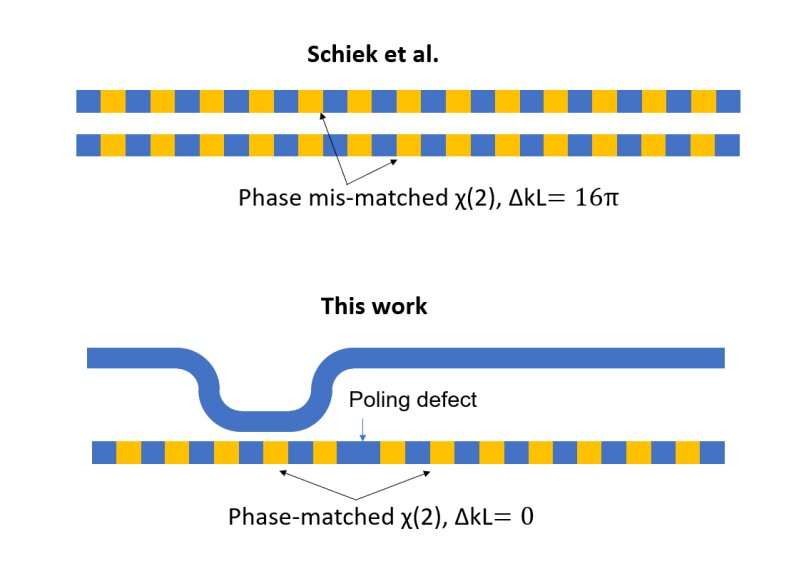August 12, 2022 feature
An ultrafast and highly performing nonlinear splitter based on lithium niobate

Optics, technologies that leverage the behavior and properties of light, are the basis of many existing technological tools, most notably fiber communication systems that enable long- and short-distance high-speed communication between devices. Optical signals have a high information capacity and can be transmitted across longer distances.
Researchers at California Institute of Technology have recently developed a new device that could help to overcome some of the limitations of existing optical systems. This device, introduced in a paper published in Nature Photonics, is a lithium niobate-based device that can switch ultrashort light pulses at an extremely low optical pulse energy of tens of femtojoules.
"Unlike electronics, optics still lacks efficiency in required components for computing and signal processing, which has been a major barrier for unlocking the potentials of optics for ultrafast and efficient computing schemes," Alireza Marandi, lead researcher for the study, told Phys.org. "In the past few decades, substantial efforts have been dedicated to developing all-optical switches that could address this challenge, but most of the energy-efficient designs suffered from slow switching times, mainly because they either used high-Q resonators or carrier-based nonlinearities."
The main objective of the recent study by Marandi and his colleagues was to leverage the inherent nonlinearity of lithium niobate to develop a highly performing optical switch. They wanted this switch to be ultrafast (in the femtosecond range) and operate in the ultra-low (i.e., femtojoule) energy regime.
When designing their device, the researchers did not integrate any resonators. Instead, they introduced two key elements that enhanced their device's switching performance, both in terms of energy consumption and speed.
"First, we utilize the spatio-temporal confinement of light in nanowaveguides to enhance the nonlinear interactions because the strength of parametric nonlinear processes depends on the peak intensity," Marandi said. "This spatio-temporal confinement was possible in nanaophotonic lithium niobate because of the nanoscale cross-section of the waveguides and the possibility of dispersion engineering, which allows femtosecond pulses to remain short as they propagate through the nanoscale waveguide."
The second characterizing feature of the device created by Marandi and his colleagues is that its nonlinear interactions' quasi-phase matching was engineered. More specifically, the team designed and changed the crystallographic orientation of lithium niobate along its nanowaveguides.
"We use a periodic pattern with an artificial defect in the middle, which deterministically switches the nonlinear process from second-harmonic generation (SHG) to optical parametric amplification (OPA)," Qiushi Guo, a postdoctoral researcher and the lead author of the paper explained. "By adding a wavelength-selective coupler before this defect, since low-energy input pulses do not lead to efficient SHG in the first half of the waveguide they will be dropped by the linear coupler. However, high-energy pulses lead to efficient SHG before the coupler and hence won't be dropped by the coupler, because the input energy will be stored in the second-harmonic wavelength of the input. After the defect, the OPA process reverts back the signal to the input wavelength."
In initial evaluations, the researchers found that their design enabled ultrafast all-optical switching, while consuming only femtojoules of energy. Specifically, their device achieved ultralow switching energies down to 80 fJ, featuring a fastest switching time of ~46 fs and a lowest energy–time product of 3.7 × 10−27 J s in integrated photonics.
"Our device design is very different from the previous all-optical switches mostly because of the way we engineered the quasi-phase matching and how we could utilize ultra-short pulses, and the resulting performance is extraordinary," Marandi said. "This is one of the most optimal ways of realizing a nonlinear optical splitter. However, we are not used to thinking about information processing in this fashion. For instance, for communication, the most widely-used way of packing information on optical signals is wavelength-division multiplexing, which is not really compatible with this switching mechanism."
The switch created by the researchers is particularly suited for what is known as time-division multiplexing, a technique of packing information into an optical signal for communication and information processing. The device's ability to support this multiplexing scheme could open unprecedented possibilities in this area, leveraging the ultra-fast speed and other advantageous qualities of optics.
"Information processing with THz clock rates could be one of the important implications of our work," Marandi said. "The possibilities in ultrafast lithium niobate nanophotonics are overwhelming."
The recent work by this team of researchers demonstrates the vast potential of integrated nonlinear photonic devices. In the future, it could help to re-think the design of photonic and optical technologies on both a device and system level.
In their next studies, Marandi and his colleagues plan to continue developing highly performing devices with unique and innovative functionalities. Their hope is to contribute to the creation of large-scale, ultrafast nanophotonic circuits and systems.
"We are also excited about utilizing our nonlinear splitter as the core of an integrated mode-locked laser," Marandi added. "The splitter can act as a 'saturable absorber', which is the main building block for passive mode locking and has been challenging to achieve in integrated photonics. The effective saturable absorption in our device has an extraordinary speed and energy-efficiency, and its design is compatible with integrated lasers."
More information: Femtojoule femtosecond all-optical switching in lithium niobate nanophotonics. Nature Photonics(2022). DOI: 10.1038/s41566-022-01044-5.
© 2022 Science X Network

















